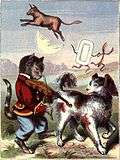Rub-a-dub-dub
| "Rub-A-Dub-Dub" | |
|---|---|
| Roud #3101 | |
| Song | |
| Written | England |
| Published | 1798 |
| Form | Nursery rhyme |
| Writer(s) | Traditional |
| Language | English |
"Rub-A-Dub-Dub" is an English language nursery rhyme first published at the end of the eighteenth century in volume two of Hook's Christmas Box[1] under the title "Dub a dub dub" rather than "Rub a dub dub". It has a Roud Folk Song Index number of 3101.
Lyrics
This rhyme exists in many variations. Among those current today is:
Rub-a-dub-dub,
Three men in a tub,
And who do you think they were?
The butcher, the baker,
The candlestick-maker,
They all sailed out to sea,
'Twas enough to make a man stare.[1]
- ^ I. Opie and P. Opie, The Oxford Dictionary of Nursery Rhymes (Oxford University Press, 1951, 2nd edn., 1997), p. 447.
Origins and meaning
The earliest versions of this rhyme published differ significantly in their wording. The first recorded version in Christmas Box, published in London in 1798, has wording similar to that in Mother Goose's Quarto or Melodies Complete, published in Boston, Massachusetts around 1825. The latter ran:
Hey! rub-a-dub, ho! rub-a-dub, three maids in a tub,
And who do you think were there?
The butcher, the baker, the candlestick-maker,
And all of them gone to the fair.[1]
- ^ Cite error: The named reference
Opie1997was invoked but never defined (see the help page).
This led Iona and Peter Opie to conclude that they were three respectable townsfolk "watching a dubious sideshow at a local fair".[2]
In the original version as it appeared both in England and in the USA (Boston) the song was talking about three maids instead of three men. Later research, according to The Oxford Dictionary of Nursery Rhymes (1951) suggests that the lyrics are illustrating a scene of three reputable men watching on the sly a less decent moment.
By around 1830 the reference to maids was being removed from the versions printed in nursery books. In 1842 James Orchard Halliwell collected the following version:
Rub a dub dub,
Three fools in a tub,
And who do you think they be?
The butcher, the baker,
The candlestick maker.
Turn them out, knaves all three.[1]
- ^ Cite error: The named reference
Opie1997was invoked but never defined (see the help page).
